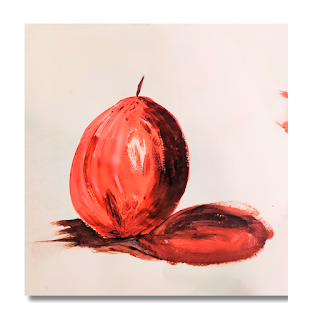- Get link
- X
- Other Apps
- Get link
- X
- Other Apps
Here’s a 4-week adult art class plan focused on exploring shape, form, shading, colour mixing, mark making, collage, and light/dark through the theme of a fruit bowl still life. This schedule integrates each concept progressively:
Week 1: Exploring Shape, Form, and Basic Shading
Objective: Understand how to break down objects into basic shapes and begin shading to create depth.
Materials:
- Pencils (B, 2B, 3B, 4B, 5B)
- Paper
- Erasers
Activity:
- Introduction to Shapes: Start by observing the fruit bowl in front of the class. Discuss how fruits can be simplified into basic geometric shapes (e.g., circles, ovals). Draw these shapes first before moving into details.
- Forming the Fruits: Once the shapes are drawn, teach how to refine these into the actual forms of the fruit.
- Shading Basics: Use pencils to shade, introducing light and shadow. Discuss how light falls on objects, creating highlights and shadows, and use this to give volume to the fruit. Practice cross-hatching, smooth shading, and stippling to show different shading techniques.
Homework/Reflection: Practice drawing more fruit, focusing on shape and applying basic shading. Encourage students to bring their sketches next week.
Week 2: Color Mixing and Understanding Tones
Objective: Learn to mix primary colours and adjust tones by adding white and brown for depth.
Materials:
- Primary colour acrylics (red, yellow, blue)
- Brown (to be mixed by blending complementary colours: mix a little red and green or orange and blue)
- White paint
- Paint palette
- Brushes
- Canvas or paper
Activity:
- Primary Color Mixing: Mix primary colours to match the colours of the fruits in the bowl. Demonstrate how adding small amounts of brown gradually darkens a colour and how adding white lightens it.
- Applying Tones: Paint the base colours of the fruit using mixed primary colours. Then, layer shades by adding small amounts of brown for shadow areas and white for highlights.
- Experimentation: Let students mix and apply colours to create depth and dimension.
Homework/Reflection: Paint another set of fruits at home, focusing on darkening colours with brown and lightening with white to enhance the form.
Week 3: Mark-Making and Collage Techniques
Objective: Introduce mark-making techniques to create texture and integrate collage for a mixed-media approach.
Materials:
- Oil pastels, charcoal, and pencils
- Scissors, glue
- Coloured paper (magazine scraps, tissue paper, etc.)
- Canvas or heavy paper
Activity:
- Mark-making practice: Start by reviewing how different materials (charcoal, oil pastels, pencils) create different marks. Have students experiment with these on the paper, adding texture to their fruit bowl compositions.
- Collage Introduction: Students demonstrate how to incorporate cut-out colored paper to add another layer of texture and interest to their compositions. They can use collages to either complement their painted or drawn fruits or to build up the background.
- Combining Techniques: Have students use mark-making and collage to add interest and texture to their fruit bowl scenes, adding a mixed-media dimension.
Homework/Reflection: Reflect on the impact of texture and collage. Students can gather materials from magazines or newspapers to use for next week’s project.
Week 4: Light and Dark, Refining the Fruit Bowl Still Life
Objective: Apply all techniques learned, focusing on light/dark contrast to give the fruit bowl a dramatic finish.
Materials:
- Charcoal, oil pastels, acrylic paint
- White and black paint
- Canvas or paper
Activity:
- Light and Dark Exploration: Recap the previous weeks’ lessons on shading, mark-making, and color mixing. Discuss how to use contrast to give the image a solid focal point. Emphasize the drama of using strong highlights and deep shadows.
- Final Still Life: Students will create a final fruit bowl still life, combining everything they’ve learned: shape, form, shading, mark-making, and collage. Guide them in balancing light and dark areas, paying attention to how light falls on the fruits and the bowl.
- Finishing Touches: Encourage students to refine their pieces, adding highlights with white and deepening shadows with black. They can also use pastels or collages for added texture.
Homework/Reflection: Reflect on the techniques that worked best for them and what they found most challenging. If the still life is unfinished, complete it at home and prepare for a class critique next week.
This progression allows students to build their skills step by step, incorporating drawing, painting, and mixed media, while keeping the fruit bowl as a consistent theme. Each week builds on the last, giving students a thorough understanding of the foundational art concepts.
- Get link
- X
- Other Apps



Comments
Post a Comment